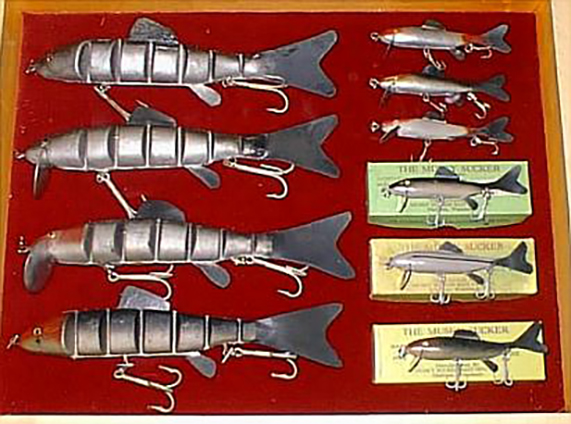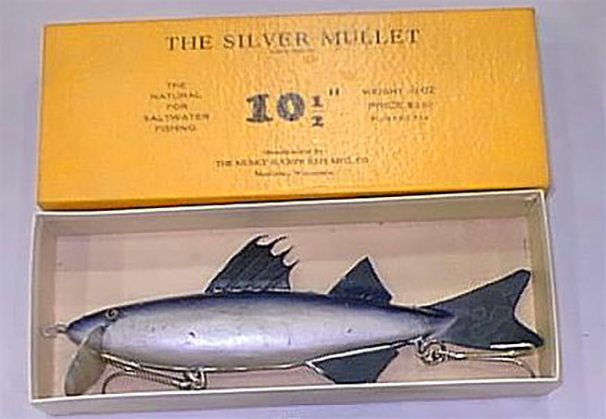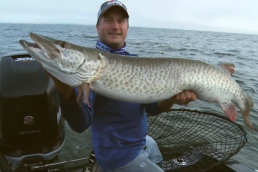Musky Sucker Bait Company
SHARE THIS POST
They say that necessity is the mother of all inventions. Well, that certainly rang true for the company we are covering today. In the mid-1920s, teenager Stanley Meier of Madison, Wisc. was told by his mother that there was no more money available for buying suckers for muskie fishing. Those of you who muskie fish know just how expensive, but effective, live suckers can be. Well, that didn’t stop young Stanley. He faced that challenge head-on and carved a “sucker” out of an old tire that was laying around. Legend has it that his handmade sucker caught a 15-pound muskie!
This experience propelled Stanley to continue to carve and refine his rubber suckers over the next decade. Stanley attended and graduated from chiropractic school. In fact, he would practice for over 40 years. Fishing, though, always remained a large part of his life. In 1939, he launched the Musky Sucker Bait Manufacturing Company out of his house.

Musky Sucker baits
In the collecting world, vintage wood and plastic lures tend to get most of the focus by tackle collectors. Rubber lures just don’t get the “respect” that the others seem to. However, that isn’t the case with the Musky Sucker Baits. They produced an entire line of rubber lures. These lures were well respected by fishermen in their day and are heavily collected today.
The first of these lures produced were Musky Suckers. They came in two sizes, 7 1/2- and 10 1/2-inch. Each size came in a surface model with a spinner on the front, and an underwater model with a metal diving lip on the front. All lures came with glass eyes set into the rubber body. These early lures held up extremely well and, to this day, most still have a smooth sheen and finish to them. The hooks were attached via through-body steel shaft construction. Note that there was an even earlier version of this lure with a rubber body and leather ribbon tail. These were very limited and quite rare.

The Musky Suckers proved to be successful and were followed up with a third size, 4 1/2 inches. The 4 1/2-inch model was only made in the underwater version. These three lures were the only lures made prior to World War II.
At the end of 1942, Meier joined the Army and served as a medic in Europe until the end of 1945. When he returned after the war, he had big plans to ramp up production on his lures and some new ideas he came up with. Like most companies, he was hit with the realities of postwar material shortages. As a result, Musky Suckers were switched from rubber to a plastic compound postwar.
Starting in 1946, the company came up with two new lures, the Flexie and the Silver Mullet. The Flexie has glass eyes and an articulated body, with seven segments of the lure connected by material that runs the length of the lure. It came in two sizes, 10 1/2- and 7 1/2-inch, both of which came in the underwater/diving and surface models.
The Silver Mullet was the one lure that continued to be made from rubber. The Silver Mullet is different from the other lures from the company in a couple of ways. It has a raised dorsal fin on the spine and has a second tail fin. It is 10 1/2 inches long and quite heavy at 8 ounces. It is equipped with 8/0 hooks and was made and marketed for saltwater fishing. The lure has the standard glass eyes seen on the rest of the company’s lures. The Silver Mullet came in both underwater and surface models.
According to the company’s sales literature, the Silver Mullet was “…made to resemble the natural Mullet in color, size, and shape. The sides are silver, accented by a strip of metallic blue green across the back.”
Are you enjoying this post?
You can be among the first to get the latest info on where to go, what to use and how to use it!
One additional note on the Flexie and Silver Mullet lures: Some research sources state these two lures only being available in the underwater models. Company sales material is scarce, and the only one I have seen shows that as well. However, I have personally seen enough surface models, both in boxes and without, to know that both were made, either as regular production or special order in significant volume. Surface models are more rare than underwater, but they do exist.
Increased production costs caused the Musky Sucker Bait Mfg. Co. to go out of business in 1948, although some stock was still sold as late as 1950.

Colors and packaging
The Musky Sucker came in Black Sucker-Natural Color, Red Head-Black Sucker-Natural Color Body, Red Head-White Body-Natural Color Tail, and Shiner Body color. The Shiner Body color only came in the 4 1/2-ich size.
The Silver Mullet only came in Natural Mullet color.
The Flexie came in Natural-Silver Sides and Black Back, Redhead-Natural Body with Red Head, and Red and Silver-Silver Body with Red Head color.
The lures came in a variety of two-piece cardboard boxes through the years. Without getting into too many details, the easiest way to date them is the following: Pre-WWII boxes will be Tan, Green or Blue. Post-WWII will either be Red or Orange (for Silver Mullet lures).
Collectors’ value
At a high level, a Madison Musky Sucker lure (including the Flexie) in excellent condition without the box would be worth anywhere from $25 to $50, depending on the color. With the matching box in excellent condition, the price would jump up to anywhere from $40 to $100. A Silver Mullet would easily double those estimates, as it is the rarest of the lures and most desired by collectors.
MWO
SHARE THIS POST
Did you enjoy this post?
You can be among the first to get the latest info on where to go, what to use and how to use it!



